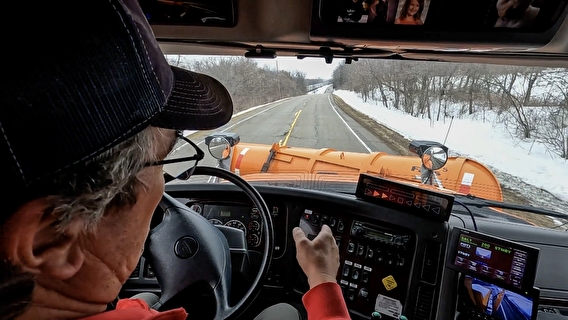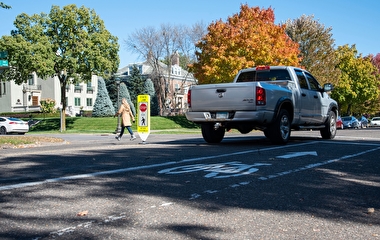
Imagine driving down the highway, looking out your windshield, and seeing nothing but a sea of white. It’s not just a nightmare for snowplow drivers—it’s a common occurrence. Snow and ice obscure pavement markings while falling or blowing snow reduces visibility, making it difficult to keep the plow centered in its lane or identify obstacles.
The good news for Minnesota’s snowplow drivers is that they may soon have help from technology. A driver-assist system (DAS) for snowplows developed by U of M researchers has been refined and is being readied for the next step in statewide deployment.
The system combines precise GPS data with high-accuracy road maps to determine the snowplow’s lane position and then show the information to the driver via an in-cab display. It’s the culmination of nearly three decades of work by U researchers and students in projects funded by MnDOT and other sponsors and partners, such as the Minnesota Local Road Research Board.
In this most recent project, researchers worked directly with snowplow operators to improve the design of the DAS through field testing over two winter seasons. An earlier round of testing had received positive feedback from drivers but also identified several potential improvements.
Max Donath, a professor with the Department of Mechanical Engineering, was the principal investigator. Co-investigators were Brian Davis, associate director of the Mobility Technology Lab, and Nichole Morris, director of the HumanFIRST Laboratory. The team’s work was honored with the CTS Research Partnership Award earlier this year.
In this round, the team worked with operators to identify opportunities for further improvement and maximize the system’s benefits. Researchers began by developing and adding a forward-hazard detection capability using a radar mounted to the top of the snowplow’s cab.
Snowplow operators provided feedback on seven potential display designs, and researchers created new designs in real time based on the input. Then they integrated three of the most preferred designs into driving simulators for operators to test, with one design ultimately chosen for field testing.
The updated system was tested in three MnDOT trucks and a Dakota County plow over the 2020–21 winter season on routes known to have blowing snow. Operators collected video and gave interviews after the snow events, prompting modifications to the display that were once again tested with operators.
Watch a video featuring the snowplow driver-assist system
Feedback from the first field testing season prompted various system improvements. Five additional plows tested the system during the 2021–2022 winter, allowing trucks in all MnDOT districts and Dakota County to participate in the study.

The redesigned system offers several new features and an interface refined through driver feedback. Using simple triangular shapes, the lane-boundary guidance system on the relatively small LCD display shows drivers where they are in relation to the lane’s center. Above the guidance system, three rectangular indicators alert the driver to a hazard to the left, straight ahead, or to the right of the front plow. Additionally, the new LCD screen (an upgrade from the earlier LED-based design) is easier to view in low-light conditions and features adjustable brightness.
“This system allows snowplow operators to stay in the lane where they couldn’t even see it before, resulting in safer and more efficient plowing in adverse conditions,” says Daniel Rowe, ITS project manager with MnDOT’s Office of Connected and Automated Vehicles.
Researchers found that snowplow operators were highly satisfied with the system during low-visibility conditions, reporting less mental workload and stress and lower involvement in run-off-the-road events or stalled vehicle strikes compared to other plows. Tests also confirmed that using the guidance system increased efficiency, with operators clearing lanes in fewer passes.
“The greatest value of this research is that operators really like the guidance system we developed,” Donath says. “One driver stated that ‘Without the system, it would be almost impossible to do the job.’”
The positive results from this study have led MnDOT to pursue wide-scale deployment of this technology. The agency is already moving forward with an implementation project led by Davis that is exploring production and operational support options for the guidance system.
Additionally, investigators will refine the forward-hazard detection function and develop a procedure for MnDOT maintenance workers to create and maintain the high-accuracy digital maps of snowplow routes necessary for the system’s operation.
—Megan Tsai, contributing writer


